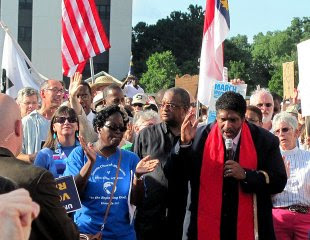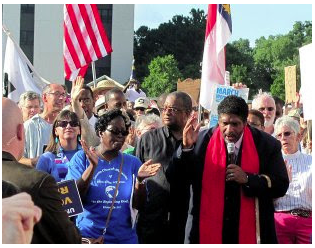
Photo Credit: twbuckner / Wikimedia
The following is an adapted excerpt from the new book No Shortcuts: Organizing for Power in the New Gilded Age by Jane F. McAlevey (Oxford University Press, 2016):
For several decades in the middle of the last century, millions of workers of all ethnicities woke up on Labor Day each year and headed for their local Labor Day march. Arm in arm they walked down the streets, singing songs of solidarity. It’s no accident that in those same years, income inequality was falling, not rising. The day in, day out preoccupation of people deeply concerned about promoting positive, progressive social change back then was building a strong workers’ movement.
The organizers of that movement, however, never saw rising incomes as their goal, nor did they limit their understanding of a strong workers’ movement to the narrow conception of a good union contract. Quite the contrary, the organizers of our biggest Labor Day marches always understood the workers’ movement to be about more than a good union contract, and much more than today’s myopic goal of merely a good wage. A strong workers’ movement was understood to be the cornerstone of a much larger project: building a just society. And for those few decades in this country, that project was succeeding.
Today, activists are divided into dozens of silos of single-issue work. Most of them fail to understand that to rebuild the kind of power the progressive project once held, we need to rebuild the workers’ movement into a robust force capable of massive, production-disrupting strikes. We saw the Verizon workers do it earlier this year, and the Chicago teachers in 2012. And the fact that some workers in some unions are actually still mounting massive, worker-led strikes—not activist-led protests simply called strikes—is evidence enough that it is, in fact, still possible.
Is it harder today? Maybe, but in analyzing what it took to build massive strikes in the 1930s and ’40s, or what it took for Blacks in the Jim Crow South to turn out by the hundreds of thousands to stare down guns, water hoses, and more—I argue that with the right strategy it can be done. That strategy must be anchored in a deep belief in the capacity of ordinary people—the main factor that separates today’s weaker protests from the great movements of the 1930s to 1960s.
The following is an adapted excerpt from my forthcoming book No Shortcuts: Organizing for Power in the New Gilded Age (Oxford University Press, 2016), available for preorder now and on bookshelves this month. The book is filled with case studies of success in the new millennium, of examples of workers who are winning because they are using the same successful strategies as the organizers of the 1930s. It matters less that the structure of capital has changed, that international trade agreements exist, that some workers have a different job structure than others. I argue that the central defining issue, the one that will determine whether or not we build the kind of power required to challenge the modern corporate class, roll back climate change, and advance a more just society, is our own strategy. It is time for a deep discussion about strategy as the single most important factor in the progressive movement today.
Smithfield Foods: A Huge Success You’ve Hardly Heard About
“Once the union understood that we had to run a campaign where race was a central issue, where race and class were given equal weight and the intersectionality of the two was lifted up, and we reframed the fight as a moral fight, we won in just two years. People trying to win these fights with morality or race off the table, versus front and center, are starting fights with one hand tied behind their back.” —Rev. Dr. William Barber, Moral Mondays, via author interview, May 2014
King County, Washington, has a population of 2 million. Ninety-three percent of its people are city dwellers; most of them live in Seattle. At the time I am writing this, the median household income is $71,175, and the average rent for a two-bedroom house is $1,123 per month. In 2014, there was a successful campaign to increase Seattle’s minimum wage to $15 an hour by the year 2022 (by which time, incidentally, that $15 will not be $15; it will be worth less, since Seattle didn’t index it to inflation). The story was banner news worldwide in print and broadcast media, and a cause célèbre for many liberals.
Meanwhile, without the fanfare of a single national headline, another kind of contract in a very different region also introduced a wage of $15 an hour. Bladen County, in southeastern North Carolina, has a population of 35,843. Ninety-one percent of those people live in the countryside; the rest are in the county’s few small towns. Thirty-five percent are African American. At the time of writing, the median income is $30,031, and the average rent for a two-bedroom house is $637 per month.
In 2008, in the county’s tiny town of Tar Heel, 5,000 workers at the Smithfield Foods pork factory voted to form a union with the United Food and Commercial Workers (UFCW). It was the single largest private-sector union victory of the new millennium.* And it happened in the South, in the state with the lowest rate of union membership in the entire country: 3 percent. The new, ratified contract not only guaranteed a $15-an-hour wage but also paid sick leave, paid vacation, health care, retirement benefits, overtime pay, guaranteed minimum work hours, job security through a “just cause” provision, and tools to remedy dangerous working conditions. The wage alone far outranks Washington’s; given the dollar’s buying power in Bladen County, King County workers would have to earn $26.40 an hour to equal it (according to my email consultation with economist Dean Baker).
Because the union signed a ‘gag order’ as part of the final deal to reach a ‘fair’ union election process, little has been said or written about the campaign since the workers won it, depriving other Southern workers of a very important example of how labor can win in the new millennium in the many manufacturing plants that have moved to the region.
The Global South within the Global North
Smithfield Foods is the largest pork producer in the world. It is a vertically integrated company that owns tens of thousands of acres of land where Smithfield farmers and contractors raise hogs that are taken to company-owned plants for slaughter, production, and packing, and then shipped to all 50 states as well as exported to China, Japan, and Europe. In the U.S. alone, the company markets twelve distinct brands, including Healthy Ones, Margherita, Farmland, and Armour. They have another fifty brands globally. Smithfield’s land ownership and farms were historically concentrated in the Deep South, because of that region’s lax environmental laws and lack of unions. But by the 1980s, Smithfield Foods had begun expanding out of the Deep South.
The first mechanism that facilitated their expansion was a rash of acquisitions of existing smaller pork producers, mostly in the Midwest. The second was the passage of the North American Free Trade Agreement (NAFTA) in 1994. NAFTA’s success, if not its key objective, depended on many domestic rules in the United States, Canada, and Mexico being changed to facilitate global capital’s mobility between the three countries.
One such change was a mandate that Mexico amend its constitution to allow foreigners to own Mexican land; previously, this had been against the law. Mexico after NAFTA would prove useful to the Smithfield company because it had basically no environmental laws and even less enforcement of what laws there were than had the U.S. South. Typical hog farms concentrate thousands of animals in small spaces, creating lake-sized waste pools containing a toxic brew of blood, bones, and guts mixed with poisons that at least theoretically stop the waste pools from generating or spreading deadly mosquito-borne or other diseases. The combination of low to no laws, zero enforcement, and a second NAFTA requirement, permission for Mexican trucks and truckers to move their rigs across the U.S. border, would make Mexico a new, strategic enclave for Smithfield.
In the late 1980s, prior to NAFTA, Smithfield had viewed North Carolina as a mini-Mexico inside the U.S. The workforce had darker skin and spoke English. A big international ocean port, a plantation legal culture, and lax laws advantaged southeastern North Carolina when the company decided to build the biggest hog plant in the world. New York Times columnist Bob Herbert described the place in a 2006 column: “Spending a few days in Tar Heel and the surrounding area—dotted with hog farms, cornfields, and the occasional Confederate flag—is like stepping back in time. This is a place where progress has slowed to a crawl.” And the pork plant in Tar Heel opened for production in 1992.
Today, 32,000 hogs a day are slaughtered and processed in this single plant. Five thousand workers staff departments with names like the Kill Floor, the Gas Chamber, and the Hanging and Rehanging Rooms. Meat production is considered one of the most dangerous jobs in the world, and a Human Rights Watch report in 2005 listed six factors that make meat factories deadly to the humans as well as the hogs: Line Speed, Close-Quarters Cutting, Heavy Lifting, Sullied Work Conditions, Long Hours, and Inadequate Training and Equipment.
In No Shortcuts‘ full chapter on this successful campaign, I highlight the decisive moments in the campaign when the strategic decisions of the key individuals made the difference between winning and losing. There’s a lengthy analysis of how the workers inside came to be empowered to build their union in what was their third attempt at unionizing the massive factory.
The Role of the Broader North Carolina Community in the Win
“The first time I remember getting called from the union was when the ICE had just raided and deported some Smithfield workers. I was driving back from Tennessee that day, where I had just been part of starting a new faith formation called the Word and the World, an effort to bring together the seminary, the sanctuary, and the streets. To make ‘The Word’ more meaningful to the world we live in.” —Rev. Nelson Johnson, Beloved Community Church, Greensboro, N.C., via author interview, May 2014
The pace of the worker campaign inside the plant was overwhelming the union staff, but it was still insufficient to bring the employer to the table. Gene Bruskin, the campaign director who by now had already helped thousands of workers inside the factory engage in multiple and massive direct worker actions, sought out national allies to launch a national consumer campaign branding Smithfield Pork as the white meat that came with human blood through human sacrifice. A young North Carolina organizer named Libby Manley had been an intern on the campaign, and Bruskin decided to make her position full-time, assigning her to engage the North Carolina community.
Reverend Nelson Johnson had attended college two decades earlier with an AFL-CIO organizer named Roz Pellas, and they were still friends. Reverend Johnson would emerge as a central player driving North Carolina religious leaders’ response to the workers’ campaign. He understood that framing (how to contextualize the fight when discussing it) was going to be key if the workers were to stand a chance, and his earliest objective was to shift the frame of the story as it was unfolding:
“First of all, I think community is a framing for all the issues we face, and in this case the leading edge of the issue at Smithfield was labor. By calling this a community struggle, we began to change the frame and break down the structural division and set it up so that if justice is the issue here, than everyone in the community is invited to be a part of the campaign. So labor isn’t an ‘other,’ some ‘Northern-based’ thing, some ‘anti-Southern’ thing; it’s actually people in our own community.” (Via author interview with Rev. Nelson Johnson, May 2014.)
Reverend Johnson decided that the Smithfield workers’ campaign would be a good North Carolina project for his new program, the Word and the World. He hosted a meeting of religious leaders from around the region and invited a longtime North Carolina farmworker leader, Baldemar Velasquez,** to come to the meeting to educate the religious leaders about two issues: unions and Latino immigrants. Reverend Johnson’s network was almost exclusively a black preachers’ network. Immigration was so new that people in the region didn’t understand it. Sarita Gupta, the head of Jobs with Justice, the group that would coordinate the national consumer boycott, reflects on this:
“It seems hard to believe now, but in 2006, we’d try to talk about the immigrant rights sub-struggle taking place in this union fight, and people would look at us and say, ‘Huh? Immigrants, in North Carolina, in a factory?’ People weren’t quite processing the rapid growth of the immigrant workforce in the U.S. South. And, the union was struggling with how to manage the conversation around immigration. The Smithfield management was as sophisticated as any we’ve seen in pitting people against each other.” (Via author interview with Sarita Gupta, May 2014.)
Reverend Johnson understood, as Gupta and Velasquez did, that the Smithfield fight could be a breakthrough in many ways for North Carolina in black-brown relations, in addition to being a potential breakthrough for the national union in the meat-packing industry and also the South. Rev. Johnson made a point of inviting a longtime colleague of his to attend the weekend meeting, a little-known pastor from Goldsboro, the Reverend Dr. William Barber.
Today, Rev. Barber is regarded as the founder and a key leader of North Carolina’s Moral Mondays movement. Back then, he had just made a successful run for president of the state branch of the NAACP. He beat a do-nothing incumbent who had routinely accepted financial contributions from Smithfield Foods during the horrific period of deportations, firings, and racist company shenanigans.
One of Rev. Barber’s first public acts as president was to refuse a check for $10,000 from Smithfield, informing the company that the NAACP would no longer be complicit in the company’s abuse of their workers’ human rights. He became a key figure supporting the Smithfield workers in their unionization effort and used the campaign against Smithfield to help renew a moribund NAACP chapter. Suddenly the workers had a historic civil rights group with considerable legitimacy in North Carolina helping to lead the charge, in addition to the emerging religious leader’s coalition.
Rev. Johnson, intent on making the Smithfield campaign a North Carolina community fight, proposed that the first action by religious leaders inside the state would be to hold twelve simultaneous pickets at North Carolina’s homegrown and very successful grocery store chain, Harris Teeter. He and the team of religious leaders picked these dozen Harris Teeter stores based whether or not they had large numbers of black customers, and on whether they had a willing partner in their religious network, a partner who could bring out sufficient people to lead the protests. Harris Teeter’s current website reflects the image-conscious nature of the grocery store, something the local pastors already understood.
The site displays page after page of “famous celebrities” who shop at Harris Teeter stores, including Dick Cheney, Tiger Woods, Tom Brokaw, and Wayne Newton. The picketers declared that Harris Teeter needed to stop selling Smithfield’s products until the company began to treat the community right. The decision to target North Carolina–based Smithfield pork in North Carolina’s home-bred and popular chain grocery with North Carolina preachers calling on the company to treat “the community” with decency was an instant success. Harris Teeter, which had a board dominated by evangelical conservatives, immediately began calling Smithfield to demand they “get these people out from in front of our stores.”
According to Bob Geary, a veteran North Carolina journalist who filed more than two dozen stories about Smithfield and is currently a columnist at the North Carolina Indy Week, “Nothing made a difference with the union campaigns all those years until they brought the campaign to Raleigh [the state capital]. No one goes to Tar Heel, it’s all by itself, this giant plant in a tiny town. Smithfield had no incentive not to fight. When they [the union] made it statewide, and made it a broad political fight, they won.” (Via author interview with Bob Geary, May 2014.)
By defeating the company, the Smithfield workers achieved much more than a contract. They won confidence in themselves. Through the vicious fight inside the pork plant, the workers also learned to take on controversial right-wing wedge issues like immigration and even gay marriage. These 5,000 workers have become key to the effort to help change the political conversation among thousands of workers in rural North Carolina. Reverends Barber and Johnson both note with home-state pride that the Smithfield workers are regular and consistent participants in the protest movement he founded in 2014, Moral Mondays. Barber believes the fight at Smithfield helped lay the groundwork for North Carolina’s newly elevated consciousness about the urgent need for unions:
“We learned to trust each other during the Smithfield fight; we deepened our ties considerably, like when we held simultaneous actions in twelve cities in North Carolina all at once, something that could only happen because the leadership of the union campaign at the time trusted the NAACP and Black Church network to lead the effort. The union had no capacity on its own to do anything like that without us.” (Via author interview with Rev. Dr. William Barber, May 2014.)
The workers at Smithfield won $15 an hour, in rural North Carolina, which is the equivalent of a $26.40 wage in Seattle; Seattle’s low-wage nonunion workers, who won $15, got far less. The Smithfield workers also developed a worker-led unified movement among previously warring ethnic factions. They’ve become a base of workers in a key national electoral swing state that still has the lowest unionization level in the United States, and they are taking on political wedge issues not as outsiders, but as home-grown North Carolinians.
That almost no workers elsewhere in the U.S. South know this story is a travesty.
Adapted from No Shortcuts by Jane F. McAlevey with permission from Oxford University Press USA. Copyright © Oxford University Press 2016 and published by Oxford University Press USA. (www.oup.com/us). All rights reserved.
Notes
*Until September 2014, when customer service agents at American Airlines voted to unionize, the Smithfield win was the largest in decades. For the American story, see Jad Mouawad, “After American Airlines-US Airways Merger, Agents Vote to Unionize,” New York Times, September 16, 2014.
**Baldemar Velasquez founded a 501c3 nonprofit mutual aid and community organization called the Farm Labor Organizing Committee. The FLOC represented the only real organizing among Latinos in North Carolina, starting mostly as a migrant workers’ organization, because when it was founded, almost none of the workers were immigrants. Rather, they were migrants, moving in for the harvest season and back out again.
Jane McAlevey has been an organizer for 25 years spanning union, community, and environmental movements. She is currently a post-doctoral fellow at Harvard Law School’s Labor and Worklife Program. She’s also still actively coaching workers (organizing). Her first book, Raising Expectations and Raising Hell (Verso, 2012) was chosen by the Nation as the “most valuable book of 2012.” Her second book No Shortcuts: Organizing for Power in the New Gilded Age, (Oxford University Press) will be available in September, 2016.















